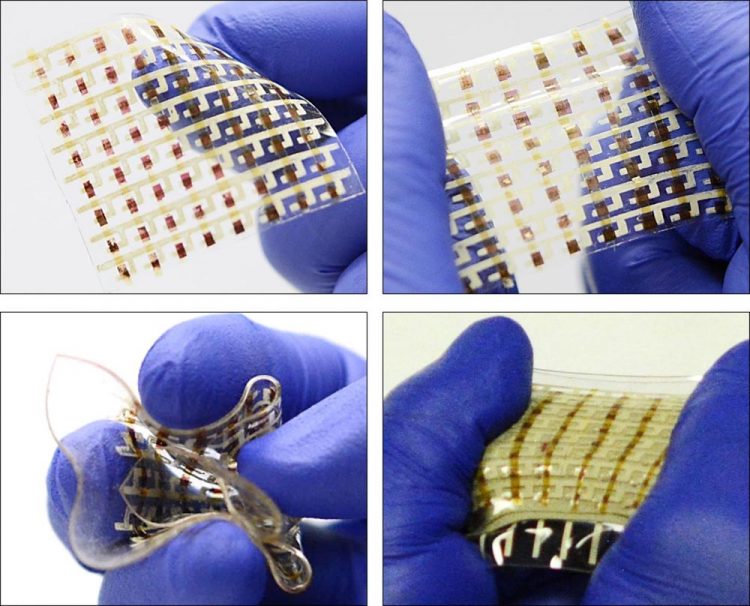Researchers report advances in stretchable semiconductors, integrated electronics

Researchers from the University of Houston have reported significant advances in the field of stretchable, rubbery electronics. Credit: University of Houston
In a paper published Friday, Feb. 1, in Science Advances, they outlined advances in creating stretchable rubbery semiconductors, including rubbery integrated electronics, logic circuits and arrayed sensory skins fully based on rubber materials.
Cunjiang Yu, Bill D. Cook Assistant Professor of mechanical engineering at the University of Houston and corresponding author on the paper, said the work could lead to important advances in smart devices such as robotic skins, implantable bioelectronics and human-machine interfaces.
Yu previously reported a breakthrough in semiconductors with instilled mechanical stretchability, much like a rubber band, in 2017.
This work, he said, takes the concept further with improved carrier mobility and integrated electronics.
“We report fully rubbery integrated electronics from a rubbery semiconductor with a high effective mobility … obtained by introducing metallic carbon nanotubes into a rubbery semiconductor with organic semiconductor nanofibrils percolated,” the researchers wrote. “This enhancement in carrier mobility is enabled by providing fast paths and, therefore, a shortened carrier transport distance.”
Carrier mobility, or the speed at which electrons can move through a material, is critical for an electronic device to work successfully, because it governs the ability of the semiconductor transistors to amplify the current.
Previous stretchable semiconductors have been hampered by low carrier mobility, along with complex fabrication requirements. For this work, the researchers discovered that adding minute amounts of metallic carbon nanotubes to the rubbery semiconductor of P3HT – polydimethylsiloxane composite – leads to improved carrier mobility by providing what Yu described as “a highway” to speed up the carrier transport across the semiconductor.
###
In addition to Yu, the paper's researchers include first author Kyoseung Sim, and co-authors Zhoulyu Rao, Anish Thukral and Hyunseok Shim, all of UH, and Hae-Jin Kim, a former postdoctoral researcher at UH who is now with Gyeongsang National University in Jinju, Korea.
Future work, Yu said, will involve further raising the carrier mobility and building more complex, hierarchy and high level integrated digital circuits to meet the requirements for integrated circuits, biomedical and other applications.
Media Contact
All latest news from the category: Power and Electrical Engineering
This topic covers issues related to energy generation, conversion, transportation and consumption and how the industry is addressing the challenge of energy efficiency in general.
innovations-report provides in-depth and informative reports and articles on subjects ranging from wind energy, fuel cell technology, solar energy, geothermal energy, petroleum, gas, nuclear engineering, alternative energy and energy efficiency to fusion, hydrogen and superconductor technologies.
Newest articles

First-of-its-kind study uses remote sensing to monitor plastic debris in rivers and lakes
Remote sensing creates a cost-effective solution to monitoring plastic pollution. A first-of-its-kind study from researchers at the University of Minnesota Twin Cities shows how remote sensing can help monitor and…

Laser-based artificial neuron mimics nerve cell functions at lightning speed
With a processing speed a billion times faster than nature, chip-based laser neuron could help advance AI tasks such as pattern recognition and sequence prediction. Researchers have developed a laser-based…

Optimising the processing of plastic waste
Just one look in the yellow bin reveals a colourful jumble of different types of plastic. However, the purer and more uniform plastic waste is, the easier it is to…



